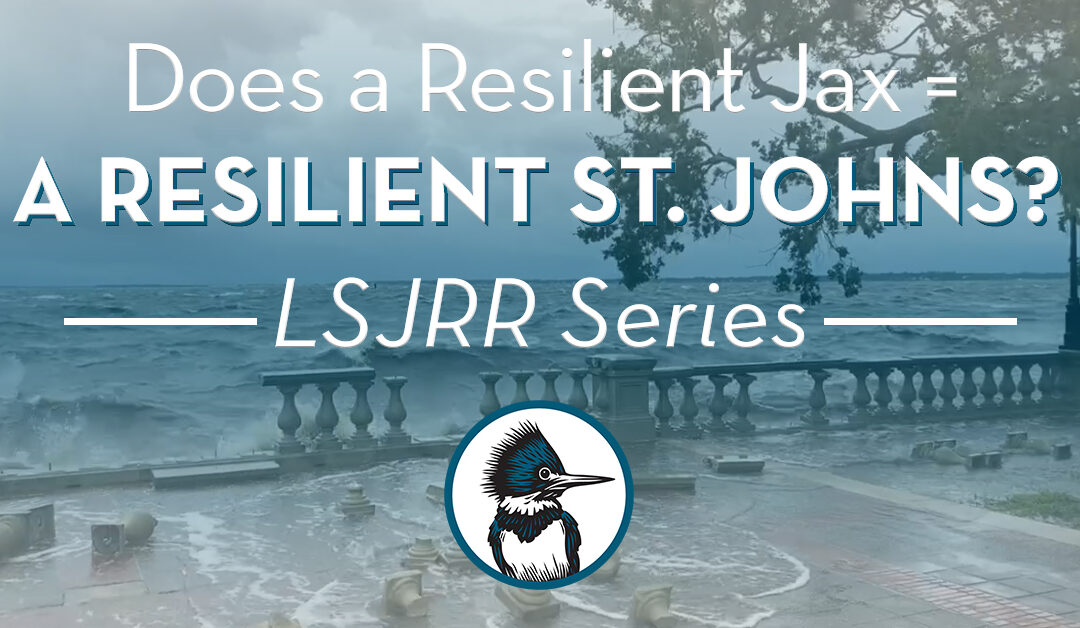As we wrap up 2023, our team is sharpening 2024 SJRK strategies to protect and restore the St. Johns River. This is the first of a six-part series teeing up our 2024 action plan.
For the past six years, we joined hundreds of community leaders to develop a resilience strategy for Jacksonville to chart a sustainable future for Northeast Florida.
The Resilient Jacksonville Strategy was released in October 2023 and provides our community with a “roadmap of how, together, we can shape our collective future.” It provides 45 actions and 90 sub-actions that, if implemented, are designed to make our communities and our environment healthier and less vulnerable to rising waters and climate change.
The key word here is implementation. While the City of Jacksonville (COJ) Chief Resilience Officer (CRO), Anne Coglianese, and new COJ Sustainability Manager, Ashante Green, are taking the lead – they cannot do so alone.
COJ is currently prioritizing the following action items as the first steps of implementing the plan:
- Action 1.1 – Updating the City’s land development regulations.
- Action 5 – Updating public works design standards to account for climate change impacts and support resilient infrastructure development.
- Action 9 – Developing a green infrastructure program across Jacksonville based on the best available stormwater science and data.
- Action 10.2 – Expanding Jacksonville’s tree canopy by developing an Urban Forest Management Plan.
- Action 19 – Strengthening emergency response and evacuation plans.
- Action 24 – Investing strategically in existing parks to increase stormwater management capacity and reduce urban heat.
- Action 40 – Establishing an Office of Resilience to facilitate the ongoing implementation of Resilient Jacksonville and to develop a compound flood model that will identify the most flood-prone areas of the city (40.2).
- Action 43 – Developing a Climate Action Plan that aligns Jacksonville’s resilience goals with actions to promote sustainability.
- Action 44 – Supporting regional resilience efforts.
Citizen engagement, support and oversight are critical to the successful implementation of COJ’s efforts.
For Jacksonville to be more resilient, we must also have a resilient, healthy St. Johns – a river with the capacity to quickly recover from extreme events and the natural ability to provide flood protection, erosion control, and water quality filtration. To do so, we must fortify our river by preventing future harm, protecting existing natural infrastructure, and restoring impaired ecosystems.
A healthy river is at the heart of a Resilient Jacksonville.
We have our work cut out for us, though. According to the 2023 Lower St. Johns River Report (LSJRR):
- Severely polluted tributaries throughout Duval County threaten human health with fecal bacteria, heavy metals and other contaminants.
- Rising water levels and increasing saltwater intrusion are changing our river’s ecology and threatening submerged aquatic vegetation (SAV) as well as the fisheries that depend on them.
- Loss of wetlands due to development and inadequate mitigation are making Northeast Florida more vulnerable to flooding.
- Climate change is making these existing problems worse and our river more vulnerable.
Follow this series on StJohnsRiverkeeper.org/blog to see how you can make a difference in 2024 working in collaboration with other river lovers throughout the watershed to implement Resilient Jacksonville actions, to restore and protect our waterways and to do our part locally to combat climate change.
What’s Next? Let’s Dive In.
This is the first of a six-part series breaking down the LSJRR, tackling our river’s vulnerabilities and charting a course to reclaim a vibrant, resilient and healthy St. Johns River. Here is what’s next:
- The River Accord: The Next Chapter
- Reclaiming Jacksonville’s Tributaries
- Florida’s Growing Sewage Crisis
- SAVing our River’s Grasses, Wetlands and Wild Land
- Calling All Watershed Warriors – Protecting 310 Miles of River, Tribs and Springs
Our river will sustain all the communities along her banks, but we must sustain our river from her headwaters, along her 310 mile journey to the Atlantic Ocean.
